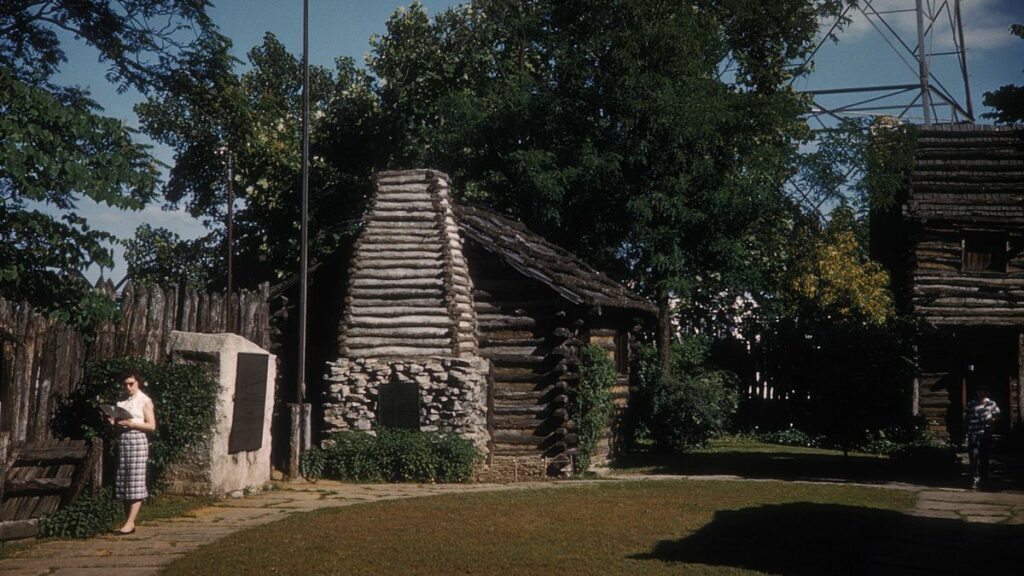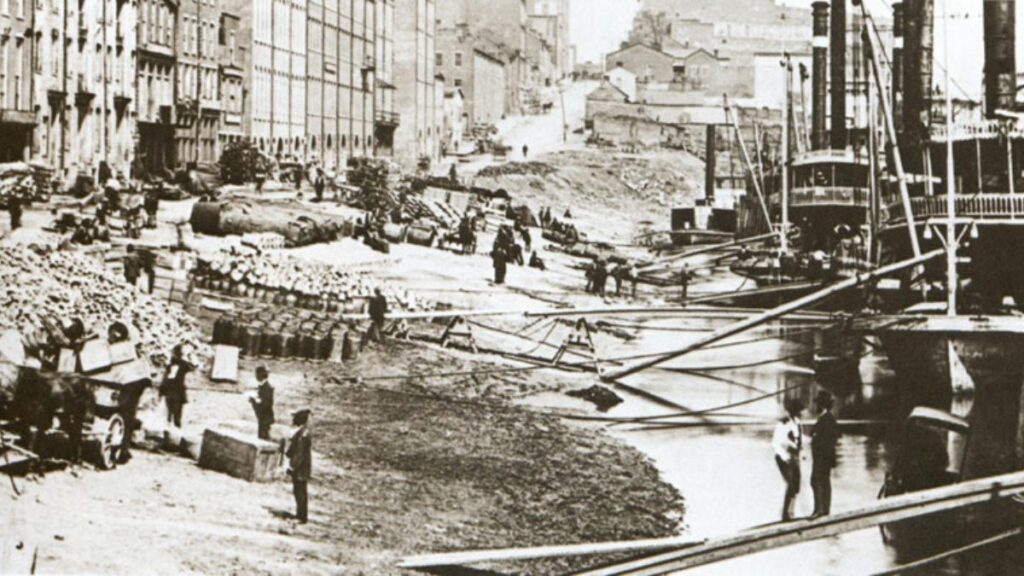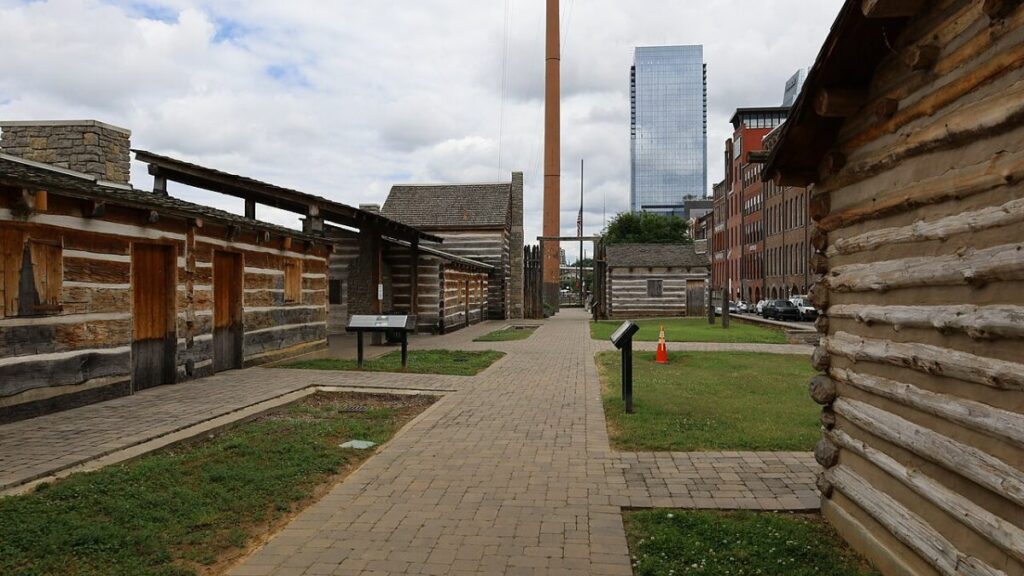This reconstructed fort, located along the banks of the Cumberland River, offers visitors a glimpse into the earliest days of Middle Tennessee’s settlement.
Originally established in 1779–1780 by pioneers James Robertson and John Donelson, the settlement was first known as French Lick Station or Bluff Station.
It was only later commemorated under the name Fort Nashborough, honoring General Francis Nash, a Revolutionary War officer.
Today, the replica serves as a museum and educational center, preserving the legacy of the settlers who braved enormous challenges to establish what would grow into Nashville.
History of Fort Nashborough

Fort Nashborough stood on the high bluffs overlooking the Cumberland River, offering a defensible position for the first Cumberland settlers.
While the fort was not part of the main Revolutionary War theaters, it represented the westward expansion of American settlement during that same period and became a symbol of survival on the frontier.
Early Settlement and Founding
In 1779–1780, James Robertson led overland settlers to the Cumberland Valley while John Donelson brought others by river.
Together, they established a stockaded station at the salt springs once frequented by Native peoples and French traders.
Constructed of log cabins and palisades, the fort provided protection, though life inside was precarious. The community formed around it became the nucleus of Nashville.
Indian Attacks and Defense
The settlement immediately faced fierce resistance. Local Native nations—especially the Chickamaugas, a Cherokee-led war faction allied with some Creek and Shawnee—saw the encroachment as a direct threat to their homelands.
Raids and sieges were frequent, the most famous being the Battle of the Bluffs in April 1781. Defenses consisted of the palisade itself and the settlers’ ability to repel sudden attacks; there is no evidence of formal “regular patrols.”
Life outside the stockade was dangerous, and survival depended on vigilance and cooperation.
Despite the constant pressure, the station endured and grew into a permanent community.
Reconstruction and the Modern Replica
By the 19th century, the original stockade had disappeared. In the mid-20th century, a replica was constructed along the riverfront to preserve the site’s history.
The modern Fort Nashborough invites visitors to step into the late 18th century, walking through reconstructed log cabins and learning about the settlers’ daily struggles and achievements.
Today, it stands as both a museum and a symbolic monument to Nashville’s beginnings.
Cornerstone of Nashville’s Heritage

Fort Nashborough’s establishment anchored settlement in the Cumberland region. Its survival encouraged further migration, eventually transforming the small frontier station into Nashville, a hub of trade and culture.
The fort’s location on the bluff offered natural protection and river access, helping shape the growth of downtown Nashville.
Academic Studies and Archaeology
Archaeological work at the Cumberland settlements highlights the deep Native presence in the area, particularly Shawnee and Chickasaw activity before Robertson’s settlers arrived.
While no archaeological evidence ties downtown Nashville directly to Chickamauga towns (which were based near present-day Chattanooga), scholarship emphasizes the violent conflict between the Cumberland settlers and Dragging Canoe’s Chickamauga faction throughout the 1780s.
For deeper study, the definitive resource is Paul Clements’ Chronicles of the Cumberland Settlements, 1779–1796, which documents the settlement’s history and conflicts in detail.
Visiting Fort Nashborough

Conservation Efforts and Community Support
Preservation groups, including the Daughters of the American Revolution (DAR), have played a role in maintaining Fort Nashborough as an educational site. Their work ensures that the story of Nashville’s early settlers—both their perseverance and the conflicts they faced—remains accessible to the public.
Through these efforts, Fort Nashborough continues to educate and inspire, serving as a reminder of the difficult origins of Nashville.
Surrounding Area and Attractions
The area around Fort Nashborough is rich with historical landmarks and modern entertainment options.
Visitors can explore the Cumberland Settlements and enjoy the bustling atmosphere of Broadway and Nashville’s diverse entertainment offerings.
Attractions Near Cumberland Settlements
The Cumberland Settlements, including Fort Patrick Henry, offer a glimpse into early American frontier life.
These sites are dotted with stations and structures that showcase the challenges and achievements of the early settlers in Middle Tennessee.
Historic sites in the area detail interactions between settlers and the Chickasaw people.
Interpretive displays provide context and stories about daily life during those times. Nearby trails make it easy for visitors to traverse the same paths as early explorers.
Broadway and Nashville Area Entertainment
Broadway, the heart of Nashville’s entertainment district, is far from Fort Nashborough. This area has live music venues, iconic bars, and various dining options for every taste.
Visitors can enjoy performances from country to contemporary music, reflecting Nashville’s musical heritage.
Landmarks such as the Ryman Auditorium and the Country Music Hall of Fame are also nearby, adding to the cultural experience.
Broadway’s vibrant nightlife makes it a must-visit for anyone in Nashville.
Explore More: Army Forts in Tennessee
Studies in Military Strategy
Studies in military strategy at Fort Nashborough often focus on its role during conflicts in the late 18th century. The Battle of the Bluffs is a key event studied to understand defensive tactics used by settlers against native groups.
Researchers analyze how the fort’s design and positioning influenced settler defense mechanisms. Alliances and skirmishes with the Cherokee and other native groups have been a major focus.
The Spanish Government’s involvement also complicates military analyses. Academic interest extends to the broader geopolitical implications of these interactions.
Explore More: 21 Historic Forts of Tennessee

Cory is a website owner and content creator who enjoys fishing, history, coin collecting, and sports, among other hobbies. He is a husband and father of four.
Romans 15:4 For whatever was written in former days was written for our instruction, that through endurance and through the encouragement of the Scriptures we might have hope.

